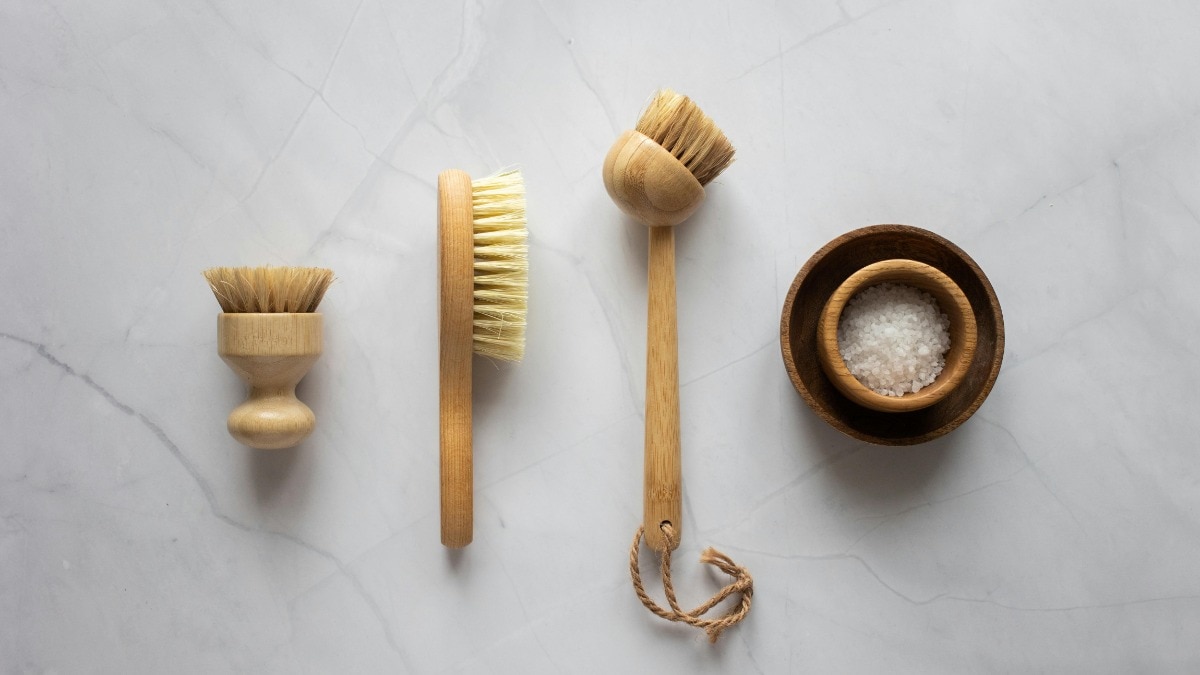
#SkinSchool: Everything you need to know about body brushing
An easy way to boost circulation while sloughing away dead skin cells.


While the wellness world is a magnet for new and niche trends, many traditional practices stand the test of time for good reason: because they work. Take dry body brushing, a centuries-old self-care ritual that remains more popular than ever: on TikTok videos relating to 'dry brushing' and 'body brushing' collectively have 313 million views and counting, while the famous and lauded never fail to recommend it in interviews. (Cindy Crawford is "a big fan", Gwyneth Paltrow uses hers "every morning", and Elle Macpherson does it every evening—from her infrared sauna...)
But if you're a recent convert, or are simply curious, the buzz on social media can be overwhelming. Here we bring it back to basics, asking the experts about the real benefits of dry body brushing—and how best to do it.
What is dry body brushing?

“It dates back to Ayurvedic and Ancient Egyptian cultures, as well as Traditional Chinese Medicine,” skincare expert Abigail James tells Bazaar. In a nutshell, “dry body brushing involves buffing dry skin with a brush, which leaves it softer and smoother” she explains. “Sloughing off dead cells also allows any body products you apply afterwards to penetrate deeper and work more effectively.”
While it does exfoliate the skin, it does not eliminate the need to use a body scrub, adds Noella Gabriel, global president and co-founder of Elemis. “Rather, it enhances the results of all the body products you use, by removing the dead skin cells that can block pores”.
Improved cell turnover also means fewer clogged hair follicles and, ergo, less chance of ingrown hairs. Good to know if that’s something you suffer from.
What are the benefits of body brushing?
Beyond the surface-level benefits, James notes that dry body brushing helps keep our body functioning well from the inside-out. “Helping to boost circulation and increase blood flow, it also stimulates lymphatic drainage and detoxification.”
Gabriel concurs, explaining that the removal of impurities from under the skin’s surface means dry body brushing is “extremely useful for encouraging cellulite deposits to disperse and for decongesting all the systems of the body”.
With many rewards to reap—at an accessible price point—dry body brushing may be a no-brainer. But consistency is key. To get the most from your dry brush, follow James’ technique tips in the morning before showering, two-to-three times a week. “And be careful to avoid any areas with broken skin, inflammation, eczema or dermatitis,” she cautions.

How to dry body brush effectively:
1. "Choose a brush with soft but firm bristles and a long handle so that you can reach your back."
2. "On dry skin, start at your feet and use long, circular sweeping motions with light-to-medium pressure. Work upwards, moving in the direction of your heart. From feet to knees, then knees to groin. You can be firmer on your thighs and bottom."
3. "When you reach your chest, use downward strokes from beneath your jaw toward your heart to encourage lymphatic drainage. Be gentler on your décolletage."
4. "Sweep upwards from hands to elbows, then elbows to armpits."
5. "Shower and follow with a hydrating body moisturiser. For limbs that feel extra parched, layer a moisturising oil underneath your body lotion."
Inbluem Lotus Wood Body Brush, ₹1,600

House of Beauty Dry Brush, ₹1,099

Amala Earth Wooden Brush with Massager, ₹799

Vega Cellulite Bristle Bath Brush, ₹630

Lead image credit: Pexels
This article originally appeared on Harper's Bazaar/UK in August 2024
Also read: #SkinSchool: The best Korean SPFs—and why they should be on your radar
Also read: #SkinSchool: The best glycolic acid products, from toners to serums—and exactly how they work










